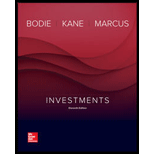
A
To calculate: The required
Introduction: The required rate of return can be defined as the amount which is expected by the investor out of the investment.
The intrinsic value of the company can be called as the actual worth of the company which includes tangible and intangible factors.
B
To calculate: The intrinsic value by using the table and the two-stage
o be.
Introduction: The required rate of return can be defined as the amount which is expected by the investor out of the investment.
The intrinsic value of the company can be called as the actual worth of the company which includes tangible and intangible factors.
C
To calculate: It is to be determined based on the comparison of the company’s intrinsic value with the current market price which the company will be recommended.
Introduction:
The required rate of return can be defined as the amount which is expected by the investor out of the investment.
The intrinsic value of the company can be called the actual worth of the company which includes tangible and intangible factors.
D
To calculate: The one strength of the two stages DDM is to be described.
Introduction:
The required rate of return can be defined as the amount which is expected by the investor out of the investment.
The intrinsic value of the company can be called the actual worth of the company which includes tangible and intangible factors.
Trending nowThis is a popular solution!

Chapter 18 Solutions
Investments
- AP Associates needs to raise $35 million. The investment banking firm of Squeaks, Emmie, andChippy will handle the transaction.a. If stock is used, 1,800,000 shares will be sold to the public at $21.30 per share. The corporation willreceive a net price of $20 per share. What is the percentage underwriting spread per share?b. If bonds are utilized, slightly over 37,500 bonds will be sold to the public at $1,000 per bond. Thecorporation will receive a net price of $980 per bond. What is the percentage of underwritingspread per bond? (Relate the dollar spread to the public price.)c. Which alternative has the larger percentage of spread?arrow_forwardGracie’s Dog Vests currently has 5,200,000 shares of stock outstanding and will report earnings of$8.8 million in the current year. The company is considering the issuance of 1,500,000 additionalshares that will net $28 per share to the corporation.a. What is the immediate dilution potential for this new stock issue?b. Assume that Grace’s Dog Vests can earn 8 percent on the proceeds of the stock issue in time toinclude them in the current year’s results. Calculate earnings per share. Should the new issuebe undertaken based on earnings per share?arrow_forwardYou plan to contribute seven payments of $2,000 a year, with the first payment made today (beginning of year 0) and the final payment made at the beginning of year 6, earning 11% annually. How much will you have after 6 years? a. $12,000 b.$21,718 c.$19,567 d.$3,741arrow_forward
- What is the full form of "CTO"? a.Central Trading Operation b.Capital take Over c.Chief Technology Officer d.Commerce Trade Officerarrow_forwardExplain. What is the full form of "EPS"? a.Exchange per Share b.Equity Private Selling c.Earnings per share d.Earning Preferred Stockarrow_forwardWhat is the full form of "MMKT"? a.Middle Market b.Management Key Trading c.Money Market d.Mutual Market Tradingexplainarrow_forward
 Essentials of Business Analytics (MindTap Course ...StatisticsISBN:9781305627734Author:Jeffrey D. Camm, James J. Cochran, Michael J. Fry, Jeffrey W. Ohlmann, David R. AndersonPublisher:Cengage Learning
Essentials of Business Analytics (MindTap Course ...StatisticsISBN:9781305627734Author:Jeffrey D. Camm, James J. Cochran, Michael J. Fry, Jeffrey W. Ohlmann, David R. AndersonPublisher:Cengage Learning
